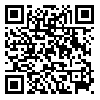Volume 2, Issue 2 (11-2020)
pbp 2020, 2(2): 28-30 |
Back to browse issues page
Download citation:
BibTeX | RIS | EndNote | Medlars | ProCite | Reference Manager | RefWorks
Send citation to:



BibTeX | RIS | EndNote | Medlars | ProCite | Reference Manager | RefWorks
Send citation to:
Shahkib P, Bahmani M, Parsaee P. Drug Interaction of Glycyrrhiza glabra L. with Chemical Drugs: A mini Review Article. pbp 2020; 2 (2) :28-30
URL: http://pbp.medilam.ac.ir/article-1-62-en.html
URL: http://pbp.medilam.ac.ir/article-1-62-en.html
1- Razi Herbal Medicines Research Center, Lorestan University of Medical Sciences, Khorramabad, Iran
2- Biotechnology and Medicinal Plants Research Center, Ilam University of Medical Sciences, Ilam, Iran ,mahmood.bahmani@gmail.com
3- Research Center of Nutrition and Organic Products, Shahrekord Branch, Islamic Azad University, Shahrekord, Iran
2- Biotechnology and Medicinal Plants Research Center, Ilam University of Medical Sciences, Ilam, Iran ,
3- Research Center of Nutrition and Organic Products, Shahrekord Branch, Islamic Azad University, Shahrekord, Iran
Abstract: (2133 Views)
Glycyrrhiza glabra L. is a valuable medicinal and nutritional plant of the Fabaceae family. In traditional medicine, it is used to treat duodenal ulcers, coughs, sore throats, inflammation, bloating, strong laxatives and antidotes, hot flashes, relieves thirst, relieves skin discomfort, and anti-allergies. The most important active ingredient in this plant is glycyrrhizic acid. G. glabra L. is a widely used plant in Iran and medicinal products have been produced from it in Iran. Interactions between herbal and chemical drugs are also common. In this review study, drug interactions between G. glabra L. and chemical corticosteroid drugs were investigated and reported. G. glabra L. can interact with a variety of chemical drugs, so concomitant use of G. glabra L. with other drugs requires caution.
Type of Study: Research |
Received: 2020/06/6 | Accepted: 2020/11/21 | Published: 2020/07/31
Received: 2020/06/6 | Accepted: 2020/11/21 | Published: 2020/07/31
References
1. Amani M, Sotudeh-Gharebagh R, Mostaoufi N, Kashani H. Optimal Exteraction of Glycyrrhetinic Acid From Licorice Root. J Technol. 2005; 3 (4):376-580.
2. Karimielise H. Information about licorice. Forest and Range. 1989; 6: 8-12.
3. Chandler F. Herbs Everyday Refrence for Healt professionals. Canadian Pharmacists Association and the Canadian Medicinal Association. 2000.
4. Akhundzadeh S. Encyclopedia of Iranian Medicinal plants. Institue of Medicinal Plants. Jahad-e Daneshgahi. 2000; 213.
5. Ghahraman A. Basic Botany: Anatomy and Morphology, Vol. 1. University of Tehran Press. 1999: 539.
6. Omidbeigi R. Processing and production of medicinal plants. Razavi Publications, Mashhad. 2006; 3: 397.
7. AOAC. Association of Official Analytical Chemists, Official method 982.19. 2002.
8. Mirhaidar H. Licorice, Herbal plants used in the treatment of diseases and education. Office of Islamic culture publication. 1994; 3: 6-12.
9. Bluemental M. Herbal medicine expanded comission emonographs. 1st ed. United States of America: Integrative Medicine Communication; 2000.
10. Mirheidar H. Botany application of plants in prevention and treatment of diseases. 4th ed. Tehran: Daftar Nashr-e-Farhang Islamic; 2003; 3: 1-20.
11. Chopin lucks B. Vitex agnus castus essential oil and menopausal balance: a research update. Complement Ther Nurs Midw. 2003; 9(3): 157-60.
12. Tyler VE, Bradly LR, Robbers JE. Pharmacognosy. 9th ed. Lea and Febiger. Philadlphia. 1988: 68-69.
13. Tyler VE, Bradly LR, Robbers JE. Pharmacognosy. 9th ed. Lea and Febiger. Philadlphia. 1988: 68-69.
14. Blumenthal M, Goldberg A, Brinckmann J. Herbal Medicine: Expanded Commission E Monographs. Newton. American Botanical Council. 2000: 233–236.
15. Hayashi H, Hiraoka N, Ikeshiro Y, Yamamoto H, Yoshikawa T. Seasonal variation of glycyrrhizin and isoliquiritigenin glycosides in the root of Glycyrrhiza glabra L. Biol Pharm Bull. 1998; 21: 987-989.
16. De Simone F, Aquino R, De Tommasi N, Mahmood N, Piacente S, Pizza C: Anti-HIV aromatic compounds from higher plants. In: Tringali C, (ed). Bioactive Compounds from Natural Sources: Isolation, Characterization and Biological Properties. Taylor and Francis Inc. New York. 2001: 325.
17. Haraguchi H. Antioxidative plant constituents. In: Tringali, C, (ed). Bioactive Compounds from Natural Sources: Isolation, Characterization and Biological Properties. Taylor and Francis Inc. New York. 2001: 348-352.
18. Mehravar M. Extraction of licorice from licorice roots by pure water and one percent aqueous ammonia solution. M.Sc. Thesis. Shiraz University, Shiraz, Iran. 1991: 107.
19. Marzi V, Circella G and Vampa GM. Effect of soil depth on the rooting system growth in Glycyrrhiza glabra L. ISHS Acta Horticulture 1993; 331: 71-78.
20. Beijnen JH, Schellens JH. Drug interactions in oncology. Lancet Oncol2004; 5(8): 489-496.
21. http://www.vitalgoods.com/myibis/herbdru g.pdf.
22. Vickers A, Zollman CA. ABC of Complementary medicine, Herbal medicine. BMJ 1999; 319: 1050-58.
23. http://www.bodyandfitness.com/bodyandfit ness1.html.
24. Shih RD. Rosens Emergency Medicine: Concepts and Clinical Practice, 5th ed, Mosby, Inc. 2002: 2204.
25. Kuhn MA. Herbal Remedies: Drug – Herb Interactions. Critical Care Nurse. 2002; 22: 22- 32.
26. Fleming T. PDR for Herbal Medicine. Second Edition; Medical economics Co. Montvale New Jersey, 2000.
27. Corponter DO. Nursing herbal medicine Handbook. Springhouse corporation, springhouse. Pennsylvania; 2001: 483-488.
28. Fugh-Berman A. Herb and drug interaction. Lancet 2000; 355: 134-8.
29. Brent J. Herbal drug interaction chart. http:// www.sdh.sk.ca/rxfiles. July 2002.
30. Mills S and Bone K. Principle and practice of phytotherapy (Modern herbal medicine). Churchill Livingstone, 2000: 104-7.
31. http://www.vitalgoods.com/myibis/herbdru g.pdf.
32. Vickers A, Zollman CA. ABC of Complementary medicine, Herbal medicine. BMJ 1999; 319: 1050-58.
Send email to the article author
| Rights and permissions | |
 |
This work is licensed under a Creative Commons Attribution-NonCommercial 4.0 International License. |






